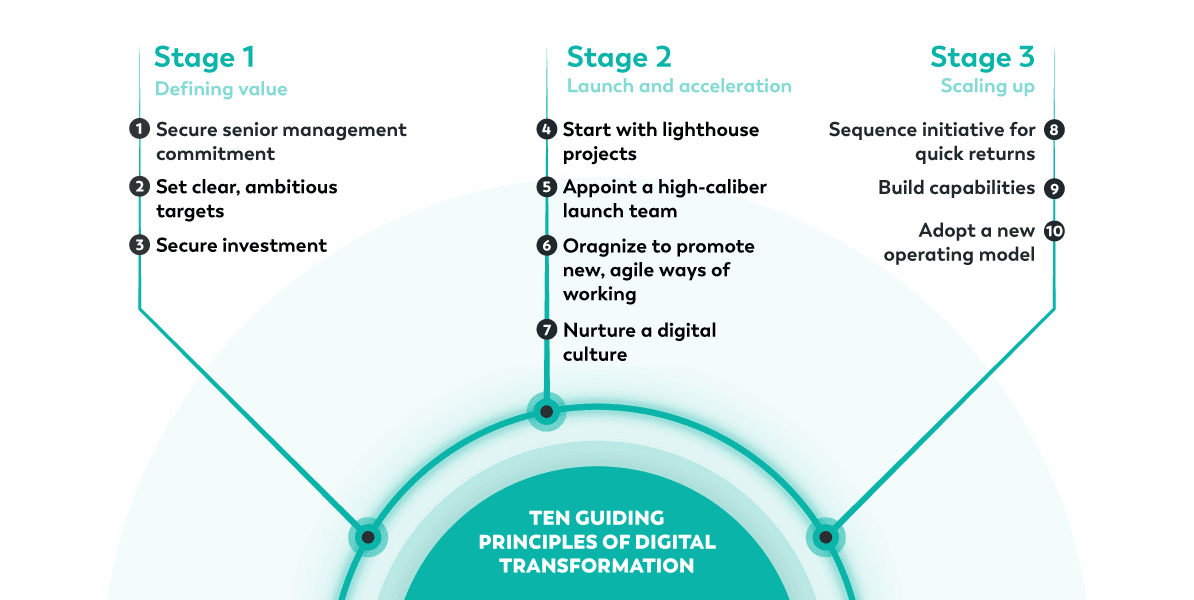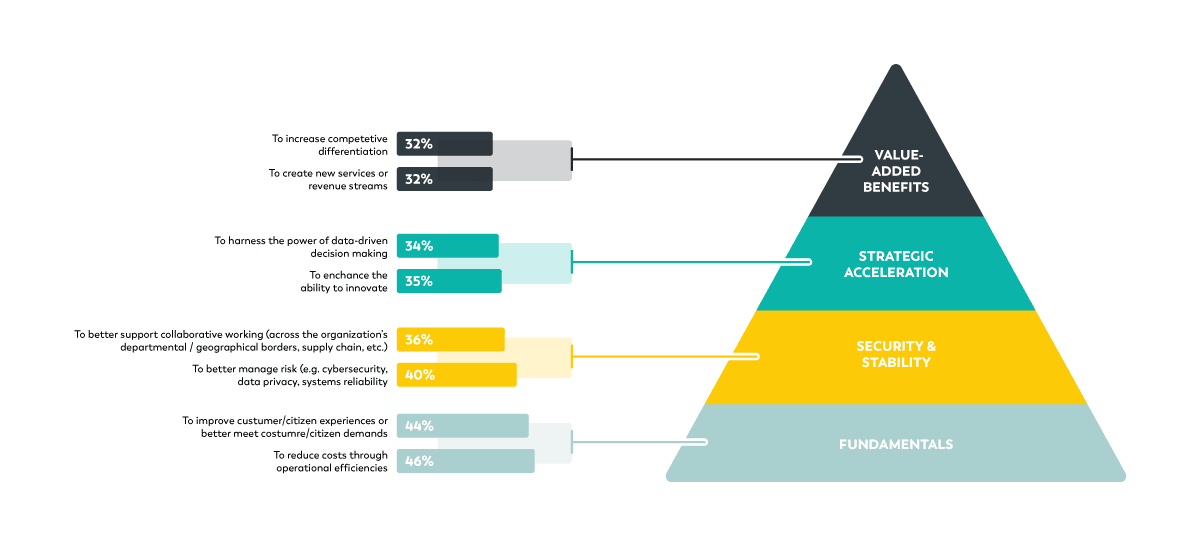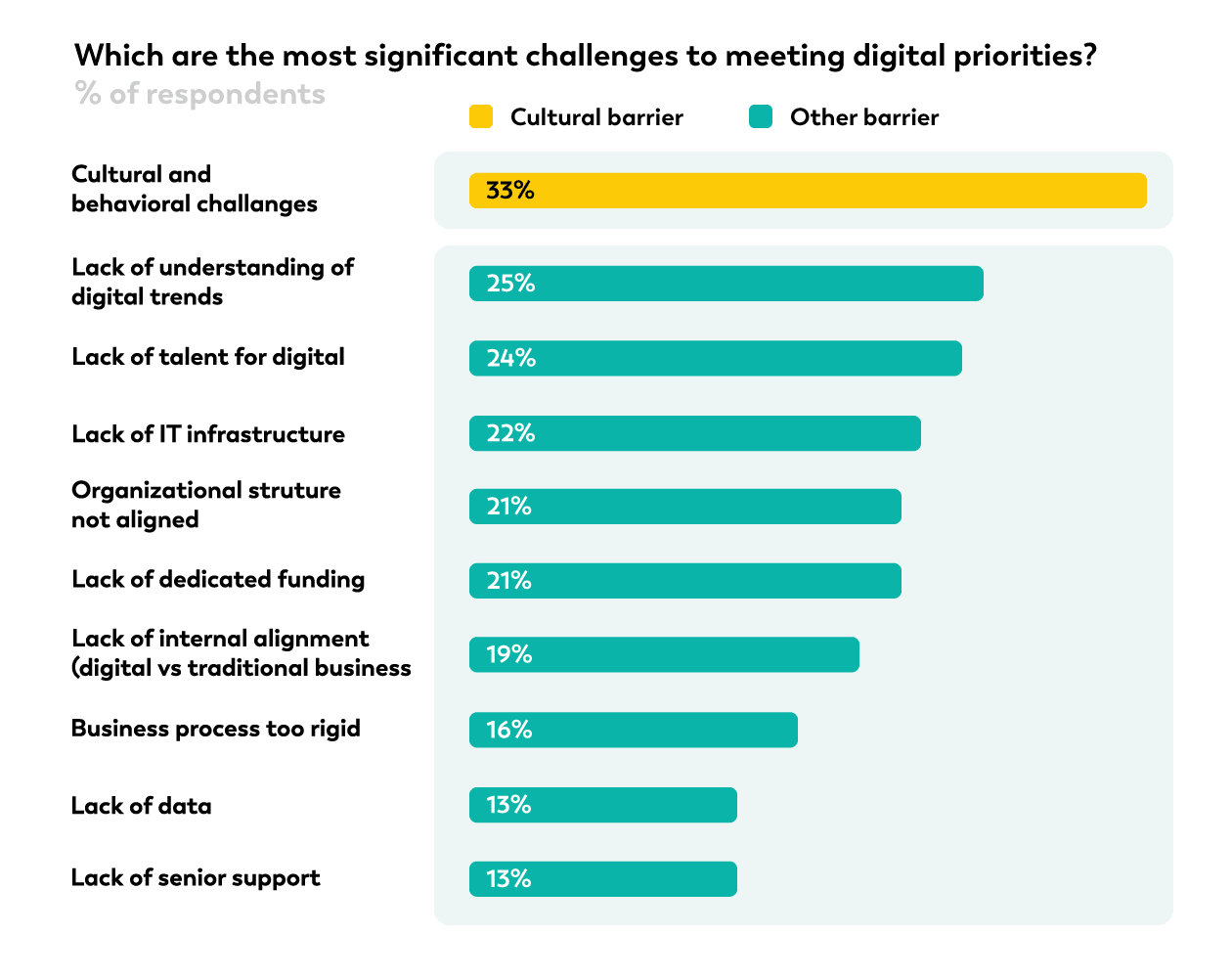Digital transformation is a term on the verge of overuse. It’s become a catch-all, describing actions as mundane as digitizing paper archives.
It’s in danger of joining the ranks of terms like blue sky thinking and big ideas—marketing buzzwords whose initial shine becomes dull and worn the more they’re used.
Still, the underlying concept of digital transformation holds a lot of power. It offers compelling advantages to companies keen on improving business outcomes. It has the potential to revolutionize company-wide efficiency and effectiveness by harnessing available technology.
When used properly, digital transformation can be every bit as revolutionary and beneficial as it once sounded.
A digital future
Digital transformation has been defined by the authors of the pioneering book Leading Digital as capitalizing on modern technologies rather than falling victim to them. Think about it: If your competitors are already communicating with customers through social media, your brand can’t afford to ignore these free platforms—let alone the positive PR resulting from publicly resolving a customer complaint or concern.
John Chambers of Cisco Systems is on record as saying, “At least 40% of all businesses will die in the next ten years […] if they don’t figure out how to change their entire company to accommodate new technologies.”
It’s important to keep in mind from the outset that this process will be different for every company. Around 90% of organizations don’t deal in technology, so they may not identify the potential ROI digital transformation can deliver. They may not even realize there’s an ROI to be made by switching to cloud computing or running analytics on digital marketing campaigns.
Many happy returns
So what does digital transformation look like? Google Cloud VP Amit Zavery summed it up as follows: “Think of digital transformation less as a technology project to be finished than as a state of perpetual agility, always ready to evolve for whatever customers want next.”
Below are four digital transformation examples from companies who capitalized on the benefits of the modern digital world, along with details of the ROIs they’ve achieved:
Société Générale
French bank Société Générale was over 150 years old before it embraced digital transformation by creating a global intrapreneurship program to encourage the development of disruptive internal projects. Shortlisted ideas had to lay the foundations for future products and services, challenging the group’s traditional methods of operation.
The result was the creation of a dedicated innovation lab in 2018, which has seed-funded 60 new businesses agile and forward-thinking enough to respond to rapid future changes in the financial services sector.
LEGO
Following a decade of steady economic decline, the future looked bleak for Danish toy manufacturer LEGO. Yet the company’s decision to embrace digital technology saved it from likely bankruptcy.
The brand metamorphosed from a dated and largely nostalgia-fuelled business into one operating at the cutting edge of mobile gaming and motion picture animation. Its first motion picture made a profit of over $400 million, and LEGO’s 2019 operating profit rose to €1.45 billion—digital transformation examples have rarely had a more dramatic effect on a company’s bottom line.
Ocado
Online supermarket Ocado has led the world in transformative fulfillment technology. It spent years creating proprietary hardware and software for automated warehousing where none previously existed, in a bid to automate and streamline customer transactions.
The end result is a world-leading warehouse near London, where over 1,700 robots collaborate to pick and pack 54,000 products stored in three-dimensional groupings of square bins stacked up to 21 deep. Ocado’s method of algorithm-based order picking and packing has cut product waste from the industry-standard 3 in 100 items to 1 in 6,000, optimizing profits in the process.
Gucci
There are plenty of digital transformation examples in the event marketing industry, though few have been as eye-catching as Gucci’s. Back in 2011, the then-struggling company added interactive video displays into its stores, allowing customers to pause, rewind, and search for content using hand gestures.
At a time when motion control was still in the realm of sci-fi movies, this level of interactivity also allowed customers to receive images on their mobile devices or reserve items through their handsets. Last year, Gucci ranked at the top of Gartner’s Digital IQ Index Rankings of luxury fashion brands.
In each of these examples, the company’s aims and objectives were radically different, as was the amount of investment required. But they all achieved their results by embracing digital technology’s full potential, transforming their fortunes, and repositioning them at the forefront of their sectors.
Guiding your digital transformation
The most successful digital transformation examples are demonstrated by companies who know these four simple rules:
-
Digital transformation starts at the top. If C-suite employees aren’t on board with digital strategies, junior staff are unlikely to persuade them of the merits of embracing technology.
-
It requires collaboration. There may be resistance to new methods or fears of a power grab, but research by McKinsey shows enterprise-wide planning strategies maximize success.
-
You need rapid results to avoid being left behind by competitors. VeryCreatives can help here—we have a track record of unveiling minimum viable products (MVPs) within three months of starting work.
-
An understanding of technology isn’t necessary. As front-end and back-end developers, our VeryCreatives team can handle all the technical aspects of turning a napkin sketch or a bright idea into reality.
With these rules in place, companies can then follow a sequence of guiding principles, which firms like McKinsey believe should support any digital transformation scheme:

The benefits of following these principles are compelling:
-
It can respond to a disruptive newcomer. Ever since Uber revolutionized on-demand taxi services, automation and communication have become far more important to consumers.
-
It can turbocharge small businesses. Digital transformation isn’t just for multinationals. A garage enterprise can be boosted by app development or powerful data processing tools.
-
It puts an end to data silos. According to PWC, fragmentation is the enemy of innovation and agility. Nowhere is that truer than data silos, which hinder efficiency and productivity.
-
It permits digital twins. This is the concept of replicating physical entities virtually, such as destruction-testing modelling software or augmented reality overlays on real environments.
-
It encourages an innovative mindset. Rather than waiting until competitors are blazing a trail, companies can preemptively adapt their offerings in response to new technologies.

Getting creative
At VeryCreatives, we have extensive experience in helping companies embrace the potential of digital technology—and transform their profits and ROI in the process. Here are some of our recent digital transformation examples (with business names omitted for privacy):
Packaging compliance
The creation of a complex and heavily scripted Excel spreadsheet has been the catalyst for intricate calculations on the process of food/beverage packaging composition. Ensuring compliance with EU, Swiss, and US packaging laws, each calculation involves thousands of raw data points. In a sign of the times, this raw information is also supplied in Excel format from global packaging producers like BASF.
Event marketing
One of eastern Europe’s largest banks has seen their complicated roster of costings, invoices, programs, and planning documents combined into a slick customer relationship management (CRM) application. This platform is accessed and controlled via an intuitive user interface (UI) that stores every asset, invoice, and invitation in one location. We even built native iOS and Android mobile apps, which can be used during the events for RSVPing, asking questions of the host, and voting on polls.
Digital sales
We produced a digital sales app for solar panel agents in America, placing a powerful selling tool in their pockets. The app’s functions include rapid calculations based on customer data, an inventory showcase, and links to a backend API that supports and tracks the whole sales process right down to product comparisons.
Go digital today and transform tomorrow
You may have a goal with no route to achieving it, or an ambition that seems unreachable due to your staff’s limited knowledge of apps and SaaS. But just because you don’t know how to make something happen doesn’t mean it can’t be done. Outsourcing can tackle many of the challenges that come with digital transformation:

By working with C-level executives, VeryCreatives can validate concepts and create revenue-generating platforms, focusing on areas that could be improved with digital solutions.
Our team of in-house developers and designers has extensive experience with successful digital transformation examples—devising effective strategies before building working prototypes and turning them into market-ready products.
We work with back-end and front-end platforms, using the power of the cloud and producing native mobile apps for Android, iOS, and wearables. We can even incorporate third-party integrations, from Twilio and Twitter to Asana and Apple Pay.
To kick off your company’s digital transformation journey, get in touch with us to book a free 30-minute consultation.